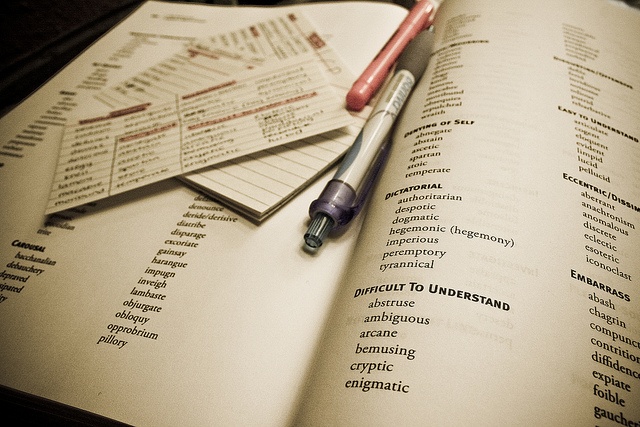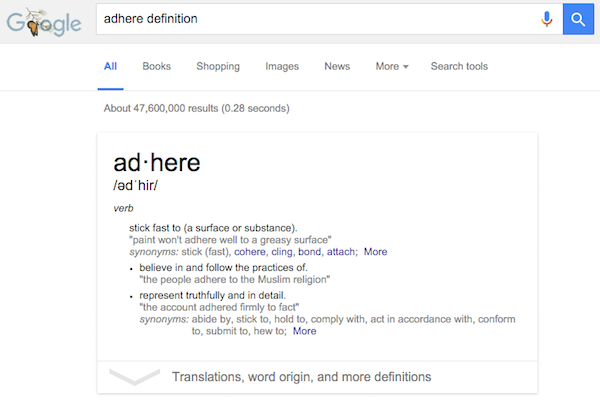
Studying for the new 2016 SAT and struggling to remember specific concepts? Flashcards might be a great study resource for you! Flashcards can help you memorize the information you need to know. In this guide, I’ll explain how to make SAT flashcards for vocabulary and math formulas and how to study with the flashcards you make.
An important disclaimer before we start: I don’t suggest using flashcards as your only method of preparation for the SAT; they should only really be used for memorizing SAT vocabulary and math formulas. Keep in mind that on the new SAT, vocabulary only accounts for 20% of the Evidence-Based Reading and Writing section questions, and it's all tested in the context of the passages. While flashcards are useful for preparing for those questions as well as memorizing Math formulas, they won’t help you learn the SAT strategies. To really improve your score, you'll need to focus on learning test strategies and taking practice tests.
Feature image credit: Deb Stgo/Flickr
Why You Should Make Your Own SAT Flashcards
I suggest creating your SAT flashcards by hand instead of buying pre-made SAT flashcards or creating online flashcards (using a website like Quizlet).
By making your own flashcards by hand, you'll start to learn the information before you even start using the flashcards. I recommend writing them out by hand because rather than creating online flashcards because when you create the flashcards online, you’ll likely end up just copying and pasting information onto the flashcards without taking the time to read the information. Making physical flashcards will require that you read and transcribe all of the material, which means you'll start to learn the material as you go.
If you don’t have a lot of time to prepare, you can download our 200 free printable SAT flashcards. But, again, if you have the time, I strongly recommend making your own physical flashcards.

Creating SAT Vocabulary Flashcards
Based on our analysis of real official SAT practice exams, we've created this list of 250+ SAT vocab words that you should start your flashcard collection off with.
When creating your vocabulary flashcards for the new 2016 SAT, since the SAT is becoming more like the ACT (testing vocabulary in context instead of using sentence completion questions), you can also use ACT vocabulary words to study. Use our PrepScholar ACT list, which teaches 150 medium-difficulty words, many with multiple meanings.
When creating the flashcards, write the word itself on one side of the card and the definition on the back. In addition to the definition, you must write an example of how to use the word in context, and if there are multiple definitions for the word, write an example of how to use the word in context for each definition.
I’ll use the first word from our PrepScholar ACT list, "adhere," as an example.
On the front of your flashcard, write:
adhere
On the back of your flashcard write:
Definition: 1. stick completely to a surface or substance 2. believe in and follow the practices of
Example: 1. I used the glue to adhere the picture to the poster. 2. The monk adhered to all of the principles of Buddhism.
Why do you need to write an example using the word in context? As I said before, on the new 2016 SAT, you’ll no longer be tested on vocabulary through fill-in-the-blank type questions. Instead, the new SAT asks you to identify the meaning of vocabulary in context. Knowing the definition of the word is vital to understanding and answering the question asked, but typically the exact meaning of the word isn’t asked about directly.
In other words, it's less about the vocabulary itself and more about how the vocabulary fits with the words around them. For example, on the new SAT Evidence-Based Reading and Writing section, you could be asked the following:
In line 84, “adhere” most nearly means
- to stick to a surface
- to dive into
- to follow the practices of
- to acknowledge as correct
Both A and C are definitions of adhere, so simply memorizing the definition will not help you answer the question. Line 38 read, “the priest adhered to Catholicism.” Knowing the definitions of adhere AND picking up on the context clues, you’d realize the correct answer is C. The answer can’t be A because the priest did not physically stick himself to a surface. The answer is C because the priest follows the practices of Catholicism.
This question shows why it’s critical to not only include definitions on your flashcards but also to include an example sentence using the word in context. If you’re struggling to come up with examples yourself (or are afraid of using the word improperly in context), I suggest conducting a Google Search for “[Word] definition.” Usually, that’ll bring up the definitions along with examples of the word used in context.
For example, I searched for “adhere definition” and found this result with examples for both definitions of the word used in a sentence.

Once you finish creating your SAT vocabulary flashcards, make flashcards for the SAT Math formulas.
Creating SAT Math Flashcards
On the SAT Math section, you're given nine math formulas and two geometry laws. However, there are many more math formulas you need to know because there are many questions you won’t be able to answer without knowing these additional formulas.
When creating your SAT Math flashcards, I recommend using our list of 21 Critical SAT Math Formulas You Must Know. This list also tells you the formulas you DON’T need to memorize (since some are given to you on the SAT test).
When making your flashcards, write the name of the formula on the front and the actual formula on the back. Also on the back, write what each variable in the formula stands for and the definition of the formula/concept. I’ll use the first formula (not provided on the SAT) from our list of 21 Critical SAT Math Formulas you must know as an example.
On the front side of my card, I'd write:
midpoint formula
On the back, I’d write:
Given two points A $(x_1, y_1)$ and B $(x_2, y_2)$, use the midpoint formula to find the exact middle point of a line that connects point A and B (the point will be equidistant from points A and B and will be in between the two).
Formula: midpoint = $((x_1 + x_2)/2) , ((y_1 + y_2)/2)$
Also, include what the variables stand for in order to remember the significance of the formula and how to use it. If you only memorize $x_1$, $y_1$, $x_2$, and $y_2$, on the day of the test, you may totally forget what $y$ and $x$ mean in the formula.
Don’t memorize formulas as a bunch of random variables. Memorize the formula, formula definition, and what each part of the formula stands for, so you’ll be prepared to use the formula to answer questions.

How to Study With Your SAT Flashcards
Now that you have your SAT flashcards, how should you use them? At PrepScholar, we recommend the waterfall method to study flashcards. This technique requires you to focus on the words/formulas you don't know, while not wasting your time on the concepts you do know. The waterfall method was developed from a proven memorization method called Spaced Repetition. I’ll give a brief overview of the method, but check out our other article for a more in-depth explanation of the waterfall method.
Start with 20-50 flashcards. I recommend studying the math formulas and Vocabulary separately, so you don’t get confused jumping between different subjects. Create a math formula pile with 21 cards. Then, create three piles of 50 vocabulary cards each (using the 150-word PrepScholar ACT list). If you decide to use an additional vocabulary list, create additional Vocabulary piles.
Go through one pile, looking at the word or formula name. If you know the definition or formula immediately, put it in a “Know It” pile. If you couldn’t remember it immediately (or at all), put it in a “Struggled” pile. After going through all of the flashcards in the original, you'll have two piles:
- a "Know It" pile
- a "Struggled" pile
Pick up the “Struggled” pile and test yourself again. This time, create a new “Know It” pile and “Struggled” pile for these flashcards. You should now have three piles:
- the original “Know It” pile
- the new “Know It” pile
- the new “Struggled" pile
Keep repeating this exercise (using the “Struggled” pile and separating into new “Know It” and “Struggled” piles) until you have five or fewer words or formulas left in the “Struggled” pile.
Now, combine the remaining “Struggled” pile with the most recent “Know It” pile. Test yourself on all of the words/formulas until you don’t get a single one wrong. If you get one wrong, restart the pile until you get zero wrong. Once you’ve mastered all of those concepts, add in the next highest “Know It” pile, and test yourself on all of those concepts until you don't get a single one wrong.
Keep repeating until you have all of your original 20-50 cards in one stack, and once you go through that stack without making a single mistake, you’ll officially know every concept in that stack! Move on to the next stack, repeating the same method.
How Much Time Should You Spend Studying Flashcards?
While flashcards are helpful for the SAT, you shouldn’t spend all of your time studying these flashcards. I'd recommend spending at most 5% of your total SAT study time (two hours if you're following our recommendation of studying about 40 hours for the SAT).
Knowing vocabulary definitions and math formulas isn't enough to help you reach a high score on the SAT. As I said before, the new 2016 SAT only tests vocab words in the context of sentences, and although knowing formulas is important for the math, you can answer the majority of the questions with only the ones provided to you.
Flashcards should be just one small part of your SAT study plan. You need to be learning other new SAT strategies, learning the content of each section on the new SAT, and taking SAT practice tests to practice applying these strategies.
What’s Next?
Concerned about the Evidence-Based Reading and Writing section on the new SAT? Learn more about the section changes and strategies.
Looking for more general new SAT prep help? Check out these guides on how to study for the new 2016 SAT and on how to figure out what’s a good new 2016 SAT score for your target school.
Want to improve your SAT score by 160 points? We have the industry's leading SAT prep program. Built by Harvard grads and SAT full scorers, the program learns your strengths and weaknesses through advanced statistics, then customizes your prep program to you so you get the most effective prep possible.
Check out our 5-day free trial today:
Have friends who also need help with test prep? Share this article!

As an SAT/ACT tutor, Dora has guided many students to test prep success. She loves watching students succeed and is committed to helping you get there. Dora received a full-tuition merit based scholarship to University of Southern California. She graduated magna cum laude and scored in the 99th percentile on the ACT. She is also passionate about acting, writing, and photography.

































 Holly R.
Holly R.